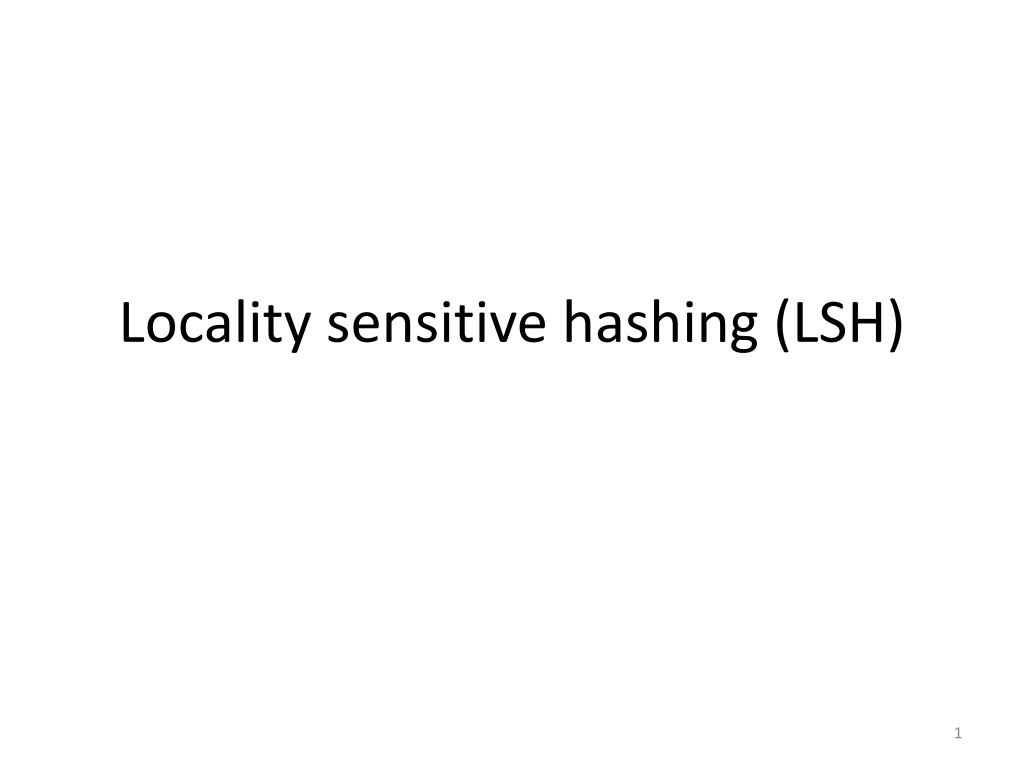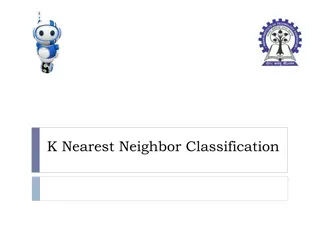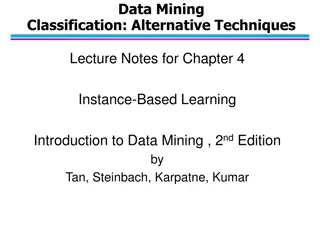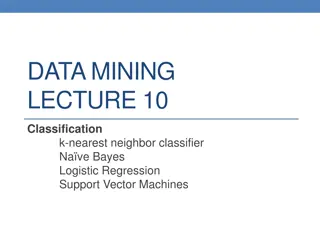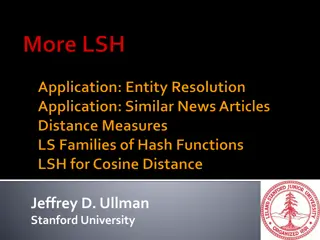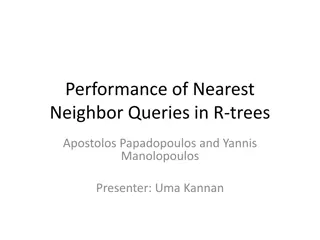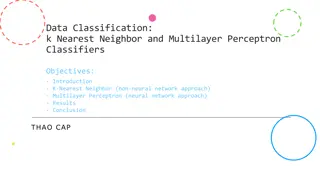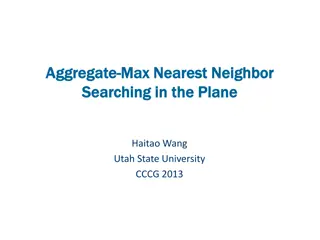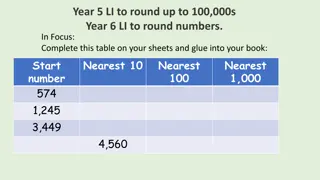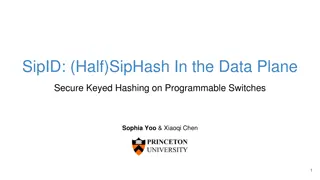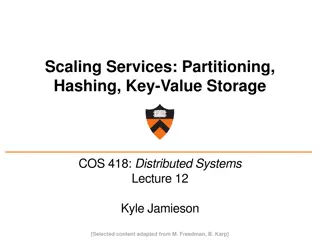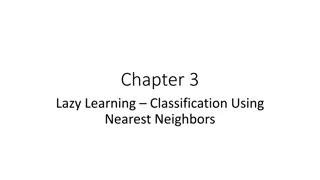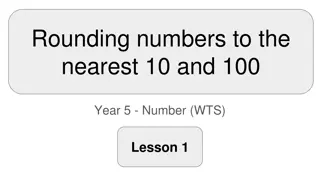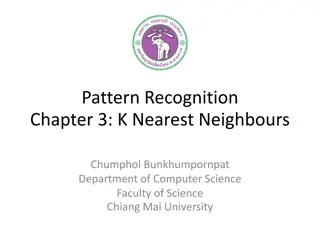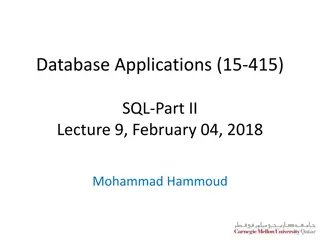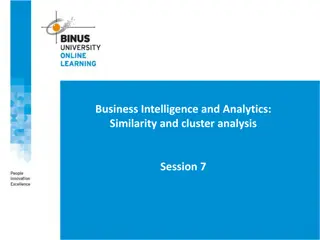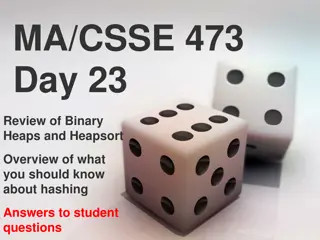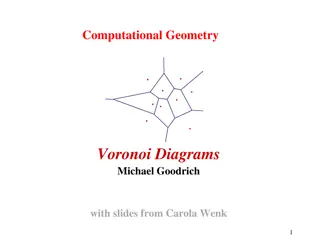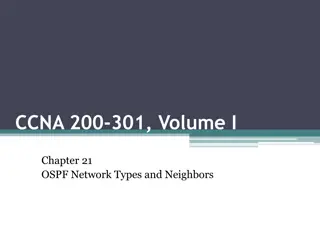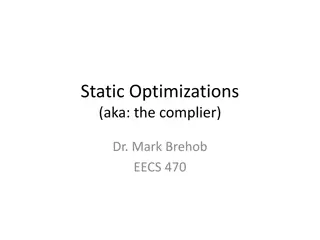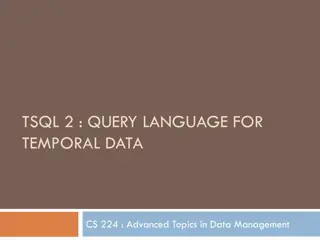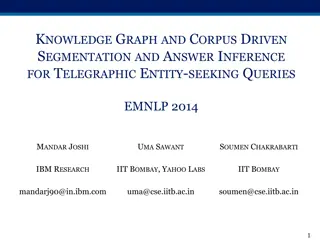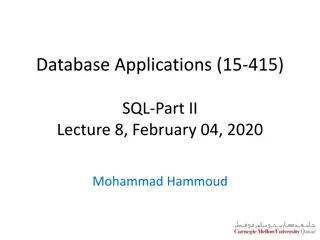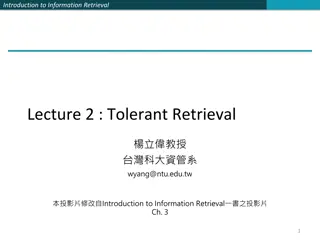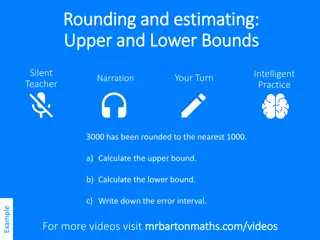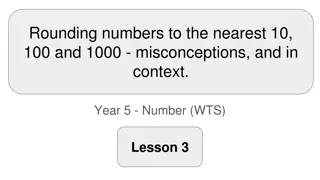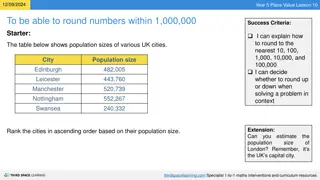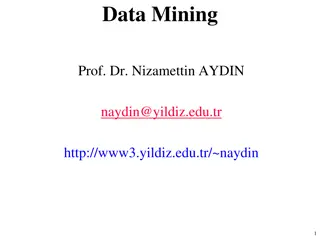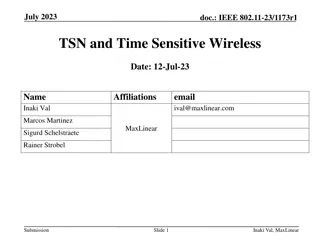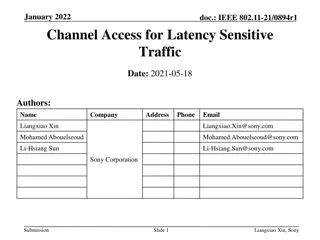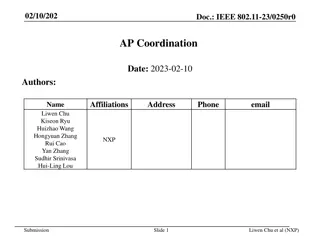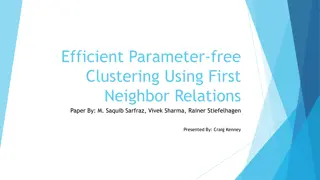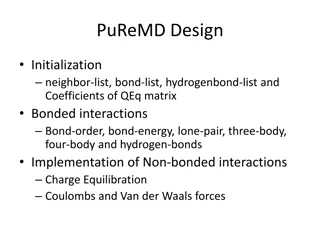Understanding Locality Sensitive Hashing (LSH) for Nearest Neighbor Queries
Locality Sensitive Hashing (LSH) is a technique used to efficiently find nearest neighbors in high-dimensional spaces. By grouping similar points into the same hash bucket, LSH enables fast search for nearest neighbors, overcoming the curse of dimensionality. Variants include k-nearest neighbors and finding all nearest neighbors in a dataset.
- Locality Sensitive Hashing
- Nearest Neighbor Queries
- High-dimensional Spaces
- Curse of Dimensionality
- Data Structures
Download Presentation

Please find below an Image/Link to download the presentation.
The content on the website is provided AS IS for your information and personal use only. It may not be sold, licensed, or shared on other websites without obtaining consent from the author. Download presentation by click this link. If you encounter any issues during the download, it is possible that the publisher has removed the file from their server.
E N D
Presentation Transcript
Nearest Neighbor Given a set P of n points in Rd 2
Nearest Neighbor Want to build a data structure to answer nearest neighbor queries 3
Voronoi Diagram Build a Voronoi diagram & a point location data structure 4
Curse of dimensionality In R2 the Voronoi diagram is of size O(n) Query takes O(logn) time In Rd the complexity is O(n d/2 ) Other techniques also scale bad with the dimension 5
Problem has many variants Approximate (will talk about this soon) k nearest neighbors All neighbors at distance ? 6
All nearest neighbors Finding the nearest neighbors of every point in the data (near duplicate web pages) 7
Locality Sensitive Hashing We will use a family of hash functions such that close points tend to hash to the same bucket. Put all points of P in their buckets, ideally we want the query q to find its nearest neighbor in its bucket 8
Locality Sensitive Hashing A family H of functions is (d1 < d2,p1 > p2)- sensitive if d(p,q) d1 Pr[h(p) = h(q)] p1 d2 d1 d(p,q) d2 Pr[h(p) = h(q)] p2 p 9
Locality Sensitive Family for a distance function ?(?,?) ?1 ?2 10
LSF for hamming distance Think of the points as strings of m bits and consider the hamming distance (?,?) H={hi(p) = the i-th bit of p} is locality sensitive wrt (?,?) Pr[h(p) = h(q)] = 1 ham(p,q)/m So this family is ?1,?2,1 ?1 ?,1 ?2 ?-sensitive 11
Jaacard distance and random permutations Think of p and q as sets jaccard(p,q) = |p q|/|p q| Jd(p,q) = 1-jaccard(p,q) = 1 - |p q|/|p q| H={h (p) = min in of the items in p} Pr[h (p) = h (q)] = jaccard(p,q) Efficiency: Need to pick from a min-wise ind. family of permutations This is (?1= 1 ?1,?2= 1 ?2,?1,?2)-sensitive family 12
Jaacard distance and minhash Think of p and q as sets Jd(p,q) = 1-jaccard(p,q) = 1 - |p q|/|p q| H={hr(p) = min ?(?), ? ?, ?~?[0,1]} Pr[hr(p) = hr(q)] = jaccard(p,q) Precision for ? should avoid ties This is (?1= 1 ?1,?2= 1 ?2,?1,?2)-sensitive family 13
Cosine distance ? and ? are vectors and ?(?,?) = ? ? ? ? 14
Cosine distance H = {hr(p) = 1 if r p > 0, 0 otherwise | r is a random unit vector} r ? ? ? 15
Cosine distance H = {hr(p) = 1 if r p > 0, 0 otherwise | r is a random unit vector} r ? ? ? Pr[ ?(?) = ?(?)] = ? 16
Cosine distance H = {hr(p) = 1 if r p > 0, 0 otherwise | r is a random unit vector} r ? ? ? Pr[ ?(?) = ?(?)] = 1 ? ? 17
Cosine distance H = {hr(p) = 1 if r p > 0, 0 otherwise | r is a random unit vector} r ? ? ? This is ?1,?2,1 ?1 ?,1 ?2 ?-sensitive family 18
Cosine distance H = {hr(p) = 1 if r p > 0, 0 otherwise | r is a random unit vector} For binary vectors (like term-doc) incidence vectors: r ? ? A B ? = 1 cos A B This is ?1,?2,1 ?1 ?,1 ?2 ?-sensitive family 19
Combining by AND Reduce the number of false positives by concatenating hash function to get a new family of hash functions h(p) = h1(p)h2(p)h3(p)h4(p) hk(p) = 00101010 We get a new family of hash functions (?) = (?) iff ?? = ?? ? If the original family is ?1,?2,?1,?2-sensitive then the new family is ?1,?2, ?1 sensitive ?- ?, ?2 20
Combining by OR Reduce the number of false negatives h(p) = h1(p),h2(p),h3(p),h4(p), ,hL(p) = 0,0,1,0,1,0,1,0 We get a new family of hash functions (?) = ? iff ? ?.?. ?? = ?? If the original family is ?1,?2,?1,?2-sensitive then the new family is ?1,?2,1 1 ?1 ?-sensitive ?,1 1 ?2 21
And k followed by Or L ?1,?2,?1,?2-sensitive ??,1 1 ?2 ??- ?1,?2,1 1 ?1 sensitive What does this do ? 22
The function 1 1 ??? k=5, L=20 1 1 ?5 20 ? For example if ?1,?2 were 0.6,0.4 then now they are (0.802,0.186) 23
(r,)-neighbor problem If there is a neighbor p, such that d(p,q) r, return p , s.t. d(p ,q) (1+ )r. r p (1+ )r 25
(r,)-neighbor problem Lets construct a data structure that succeeds with constant probability Focus on the hamming distance first 26
NN using locality sensitive hashing Take a (r1 , r2, p1 , p2) = (r , (1+ )r, 1-r/m , 1-(1+ )r/m) - sensitive family If there is a neighbor at distance r we catch it with probability p1 27
NN using locality sensitive hashing Take a (r1 , r2, p1 , p2) = (r , (1+ )r, 1-r/m , 1-(1+ )r/m) - sensitive family If there is a neighbor at distance r we catch it with probability p1 so to guarantee catching it we need to or 1/p1 functions.. 28
NN using locality sensitive hashing Take a (r1 , r2, p1 , p2) = (r , (1+ )r, 1-r/m , 1-(1+ )r/m) - sensitive family If there is a neighbor at distance r we catch it with probability p1 so to guarantee catching it we need to or 1/p1 functions.. But we also get false positives, how many ? 29
NN using locality sensitive hashing Take a (r1 , r2, p1 , p2) = (r , (1+ )r, 1-r/m , 1-(1+ )r/m) - sensitive family If there is a neighbor at distance r we catch it with probability p1 so to guarantee catching it we need to or 1/p1 functions.. But we also get false positives, how many ? ??2 ?1 ?(1 1 ?2 1 ?1) 30
NN using locality sensitive hashing Take a (r1 , r2, p1 , p2) = (r , (1+ )r, 1-r/m , 1-(1+ )r/m) - sensitive family Make a new function by concatenating ( and ) k of these basic functions We get a (r1 , r2, (p1)k, (p2)k) sensitive family If there is a neighbor at distance r we catch it with probability (p1)k so to guarantee catching it we need L=1/(p1)k functions. We get a (r1 , r2, 1-(1-(p1)k)L , 1-(1- (p2)k)L ) sensitive family But we also get false positives in our 1/(p1)k buckets, how many ? n(p2)k/(p1)k 31
(r,)-Neighbor with constant prob Scan the first 4n(p2)k/(p1)k points in the buckets and return the closest A close neighbor ( r1) is in one of the buckets with probability 1-(1/e) There are 4n(p2)k/(p1)k false positives with probability 3/4 Both events happen with constant prob. 32
Analysis k p p k Total query time: (each op takes time prop. to the dim.) + n 2 ( ) k p 1 1 We want to choose k to minimize this. time 2*min k 33
Analysis k p p k Total query time: (each op takes time prop. to the dim.) + n 2 ( ) k p 1 1 We want to choose k to minimize this: k ( ) k 1 p n k = k n p = 2 2 = (loglog ) log ( ) n k n 1 p 2 34
Summary k p k p p Total query time: + n 2 ( ) k 1 1 Put: ? = log 1p2(?) log 1p2(?) log ? 1p2 log 1/?1 log 1/?2 =1 1 ?1 1 1 ?1 =1 ?1?? ? ?1n ?1 ?1 ?1??=1 space: ?1n1+? 35
What is ? 1 p r m + log log 1 ( ( ) ) log log p p 1 + = = = 1 1 (1 ) r 1 1 p log 1 2 log m 2 36
(1+)-approximate NN Given q find p such that p p d(q,p) (1+ )d(q,p ) We can use our solution to the (r, )- neighbor problem 37
(1+)-approximate NN vs (r,)- neighbor problem If we know rmin and rmax we can find (1+ )- approximate NN using log(rmax/rmin) (r, /2)-neighbor problems r p (1+ )r 38
LSH using p-stable distributions Definition: A distribution ? is 2-stable if when X1, ,Xd are drawn from ?, ????= ? ? where ? is drawn from ?. So what do we do with this ? h(p) = piXi h(p)-h(q) = piXi - qiXi = (pi-qi)Xi=||p-q||X 39
LSH using p-stable distributions So what do we do with this ? h(p) = (pX)/r Pick r to maximize r 40
Bibliography M. Charikar: Similarity estimation techniques from rounding algorithms. STOC 2002: 380-388 P. Indyk, R. Motwani: Approximate Nearest Neighbors: Towards Removing the Curse of Dimensionality. STOC 1998: 604-613. A. Gionis, P. Indyk, R. Motwani: Similarity Search in High Dimensions via Hashing. VLDB 1999: 518-529 M. R. Henzinger: Finding near-duplicate web pages: a large- scale evaluation of algorithms. SIGIR 2006: 284-291 G. S. Manku, A. Jain , A. Das Sarma: Detecting near- duplicates for web crawling. WWW 2007: 141-150 41
